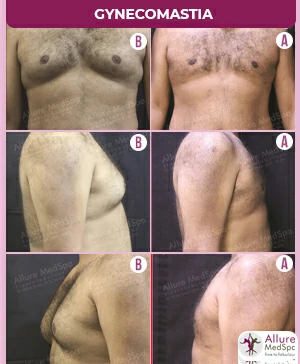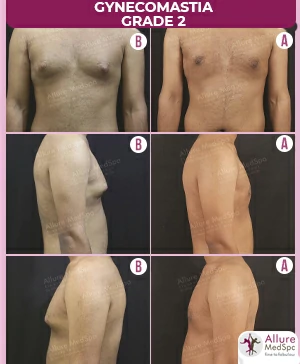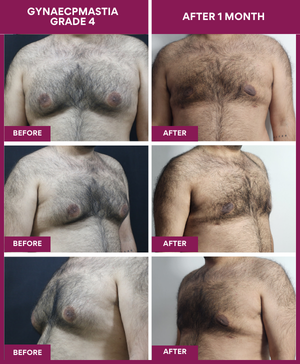Gynecomastia Surgery Cost in Mumbai – Transparent, Safe & Personalized by Dr. Milan Doshi
What Is the Average Gynecomastia Surgery Cost in Mumbai?
At Allure Medspa, the average male breast reduction (gynecomastia) cost ranges from ₹ 55 000 to ₹ 1 20 000 for both sides.
Pricing depends on the grade of gynecomastia, type of anaesthesia, and technology used.
Most men undergo VASER-assisted liposuction + gland removal under local anaesthesia as a day-care procedure — no overnight stay required.
“The right cost reflects personalized care, not shortcuts. Every chest is unique.”— Dr. Milan Doshi
Other Links: Gynecomastia Surgery | Gynecomastia Before After Images
Global & Indian Statistics (ISAPS 2024)
- Worldwide: 1,658,615 breast augmentation procedures in 2023 (ranked #2 surgical procedure; decreased vs 2022).
- India: 47,690 breast augmentations in 2023.
- Who’s getting it: The majority are aged 18–50 (ISAPS age distribution), but the report does not publish the exact 18–34 / 35–50 percentage split.
Source: ISAPS Global Survey 2024
Get Your Personalized Gynecomastia Cost & Treatment Plan in Minutes
Gynecomastia Surgery Before After Results
See How Real Men Regained Confidence After Gynecomastia Surgery
Gynecomastia Surgery Testimonials: Fine To Fabulous Journeys
Awarded by Google.com
Rating: 4.7
Reviews: 485+
Awarded by WhatClinic.com
Rating: 4.8
Reviews: 119+
Awarded by Realself
Rating: 4.9
Reviews:453+
Awarded by Facebook
Rating: 4.6
Reviews:105+
Dr Milan Doshi and his staff are very professional and committed as the centre is highly equipped with advanced technology. I had closed rhinoplasty 4 months back and I’m seeing the results as to how it becomes successful.
Deepika Shetty
The doctor explained everything clearly and the surgery was smooth. Recovery was faster than I expected and the team was very supportive.
Rahul Mehta
Very natural results and excellent staff. From consultation to follow-up, the experience was outstanding and boosted my confidence.
Sneha Kapoor
Real Stories. Real Confidence. Are You Ready to Start Yours?
Video: Gynecomastia Surgery Explained by Dr Milan Doshi
Dr Milan Doshi is describing the Male Breast Reduction Surgery in detail with benefits, candidacy, associated risks and significance
Watch How Dr. Milan Doshi Helps Men Regain Confidence — Understand What’s Right for You
Average Cost Breakdown by Grade
Gynecomastia surgery costs differ based on chest grade and treatment complexity. Use this simple cost breakdown to know what to expect in advance.
Grade | Procedure Complexity | Typical Range (₹) | Anaesthesia | Hospital Stay |
|---|---|---|---|---|
Grade 1 – 2 | Small fat + gland | 55 000 – 75 000 | Local | Day care |
Grade 3 | Large gland / dense fat | 75 000 – 1 00 000 | Local / GA | Day care |
Grade 4 | Excess skin ± 2-stage | 1 00 000 – 1 20 000 + | GA | 1 night |
Includes surgeon fee, anaesthesia, OT, garment & two follow-ups.
Excludes pre-op tests and travel (if applicable).
Sources: 🔗Mayo Clinic – Gynecomastia
Get Your Personalized Gynecomastia Cost — Verified by Dr. Milan Doshi’s Team
What Factors Affect Gynecomastia Surgery Cost in Mumbai?
Gynecomastia surgery costs vary based on multiple factors like grade, anaesthesia, technology, surgeon expertise, and hospital standards.
Factor | Effect on Cost |
|---|---|
Grade / Size | More fat or skin → longer OT time |
Anaesthesia Type | Local is 20 – 30 % more affordable than GA |
Technology Used | VASER / PAL adds precision & safety |
Surgeon’s Expertise | Board-certified senior surgeon = predictable result |
Hospital Standards | NABH protocol & dedicated OT ensure safety |
Follow-Up Care | Includes garment + consult — no hidden charges |
Sources: 🔗NHS – Gynaecomastia
Every Case Is Different — Find Out What’s Affecting Your Gynecomastia Cost
How Technology Influences Your Cost and Results
Advanced technologies like VASER, PAL, and Laser Tightening impact your gynecomastia surgery cost, recovery time, and final results.
Technology | Role | Patient Benefit |
|---|---|---|
VASER Ultrasound Liposuction | Liquefies fat & contracts fibers | No skin cuts → shorter recovery |
MicroAire PAL | Power-assisted precision | Smooth contour, less bruising |
Laser Tightening (optional) | Improves skin tone | Avoids skin-excision cost |
Technology reduces hospital time and recovery — delivering premium results at an affordable cost.
Sources: 🔗MedlinePlus – Gynecomastia
Discover Which Technology Can Give You the Best Results — Backed by Dr. Milan Doshi’s Expertise.
Local vs General Anaesthesia – How It Changes Cost
Local or General anaesthesia can change your surgery cost, comfort, and recovery. This comparison helps you choose what’s right for you.
Anaesthesia Type | Best For | Cost Range (₹) | Monitoring | Stay |
|---|---|---|---|---|
Local | Grade 1 – 3 | 55 000 – 90 000 | Multipara Monitor | Day care |
General | Grade 4 / Revision | 90 000 – 1 50 000 | CONOX + Multipara | 1 night |
All local-anaesthesia cases are continuously observed on multipara monitors (heart rate, ECG, SpO₂, BP).
General-anaesthesia cases use CONOX + multipara for precise depth control.
Sources: 🔗Cleveland Clinic – Anaesthesia
Still Confused About Local vs General Anaesthesia? Get a Doctor’s Honest Opinion.
Safety & Standards at Allure Medspa (Vardan Hospital Division)
From NABH-grade OT to expert nursing and advanced monitoring, Allure Medspa ensures a safe, infection-free and comfortable cosmetic surgery experience.
- NABH-protocol Operation Theatre
- ETO-sterilized instruments (Zero infection track record)
- Dedicated cosmetic nursing team
- Multipara monitoring for local anaesthesia cases
- CONOX neuro-monitor for GA cases
- Out-station patient care & overnight stay facility
Exclusive cosmetic hospital setup means no mix of general patients — personalized and safe environment.
Sources: 🔗WHO – Infection Prevention & Control
Experience cosmetic surgery in a specialist, safety-led hospital environment.
Why Choose Dr. Milan Doshi for Gynecomastia Surgery
Choosing the right surgeon defines your gynecomastia result. Here’s why Dr. Milan Doshi is trusted for natural, masculine chest contouring.
Credential | Highlight |
|---|---|
Qualification | M.Ch (Plastic Surgery) |
Fellowships | Director – ISAPS, IAAPS & MUHS Fellowship Centre |
Experience | 26 + years, 6000 + gynecomastia cases |
Teaching | Trained 80 + plastic surgeons worldwide |
Media Recognition | Featured in national TV & medical journals |
“It’s not only about removing tissue — it’s about creating a masculine shape that looks naturally you.” — Dr. Milan Doshi
Sources: 🔗Dr. Milan Doshi | ISAPS
Trusted by 6000+ Men for Safe, Natural & Confident Results — You Could Be Next.
What’s Included and Excluded in the Cost
Knowing what’s covered in your gynecomastia surgery package avoids surprises later. Here’s a quick look at inclusions and optional add-ons.
Included | Excluded |
|---|---|
Surgeon fee, anaesthesia, OT charges | Pre-op tests (if required) |
Compression garment | Travel / stay (for outstation patients) |
Two follow-up visits | Optional add-ons (Laser tightening etc.) |
Read More: Cosmetic Surgery Preparation for Safe and Smooth Recovery
Get a Transparent, All-Inclusive Cost Breakdown — No Hidden Fees, No Surprises.
How Does Mumbai Cost Compare to Other Indian Cities?
Gynecomastia surgery cost varies across Indian cities based on technology, surgeon expertise, and hospital standards. Here’s a quick comparison.
City | Average Range (₹) | Highlights |
|---|---|---|
Mumbai | 55 000 – 1 20 000 | VASER + PAL, fellowship hospital |
Delhi | 55 000 – 1 10 000 | Large volume centres |
Bangalore | 60 000 – 1 25 000 | Premium infrastructure |
Chennai | 50 000 – 1 00 000 | Moderate pricing |
Pune | 50 000 – 90 000 | Compact set-ups |
Considering Travelling to Mumbai? Get Help with Stay, Travel & Surgery Planning.
Medical Code for Gynecomastia Surgery
CPT and ICD-10 Codes for Gynecomastia Surgery
| CPT Code | Description | ICD-10 Code |
|---|---|---|
| 15876 | Suction-assisted lipectomy; head and neck | Z41.1 |
| 15877 | Suction-assisted lipectomy; trunk (commonly used for gynecomastia surgery) | Z41.1 |
| 15879 | Suction-assisted lipectomy; lower extremity | Z41.1 |
| 15839 | Excision of excess skin and subcutaneous tissue; other area (used for gland excision if needed) | Z41.1 |
| 19300 | Mastectomy for gynecomastia (specific to glandular tissue removal) | N62 |
FAQs on Gynecomastia Surgery Cost
Q1. Why does cost differ from one clinic to another?
Ans. Experience, technology and safety protocols vary widely.
Q2. Is gynecomastia surgery covered by insurance?
Ans. No — it’s a cosmetic procedure.
Q3. Is EMI available?
Ans. Yes, 0 % EMI plans through Allure Medspa care desk.
Q4. Does higher cost mean better results?
Ans. Not always — skill, safety and transparency matter most.
Still Have Questions About Gynecomastia Surgery?
Related Links
Note: The author of this content is Dr. Milan Doshi, An Indian board-certified plastic & cosmetic Surgeon wholly & solely confirms the authenticity of the information & knowledge delivered by this write-up.





















